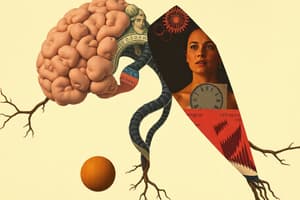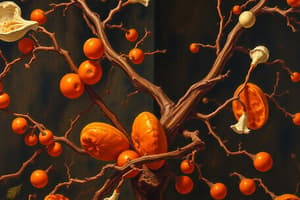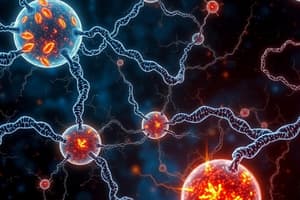Podcast
Questions and Answers
What metabolic process involves the storage of glucose as glycogen?
What metabolic process involves the storage of glucose as glycogen?
- Glycogenolysis
- Glycogenesis (correct)
- Gluconeogenesis
- Glycolysis
Which hormone primarily stimulates hepatocytes and skeletal muscle cells to synthesize glycogen?
Which hormone primarily stimulates hepatocytes and skeletal muscle cells to synthesize glycogen?
- Epinephrine
- Glucagon
- Insulin (correct)
- Cortisol
What is the approximate amount of glycogen that the body can store?
What is the approximate amount of glycogen that the body can store?
- 500g (correct)
- 1000g
- 100g
- 250g
What metabolic process involves the release of glucose from glycogen stores?
What metabolic process involves the release of glucose from glycogen stores?
Which hormones stimulate glycogenolysis?
Which hormones stimulate glycogenolysis?
In what location is glycogen broken down into glucose and released directly into the blood?
In what location is glycogen broken down into glucose and released directly into the blood?
What is the intermediate product formed when glycogen stored in muscle is broken down?
What is the intermediate product formed when glycogen stored in muscle is broken down?
Why can't skeletal muscle directly release glucose into the bloodstream during glycogenolysis?
Why can't skeletal muscle directly release glucose into the bloodstream during glycogenolysis?
Which metabolic process involves the synthesis of glucose from non-carbohydrate sources?
Which metabolic process involves the synthesis of glucose from non-carbohydrate sources?
Which of the following is a substrate that can be used in gluconeogenesis?
Which of the following is a substrate that can be used in gluconeogenesis?
Which of the regulatory hormones stimulates gluconeogenesis?
Which of the regulatory hormones stimulates gluconeogenesis?
In which organ does gluconeogenesis primarily occur?
In which organ does gluconeogenesis primarily occur?
How are lipids transported in the body?
How are lipids transported in the body?
What is the main structural characteristic of lipoproteins?
What is the main structural characteristic of lipoproteins?
What components form the outer shell of lipoproteins?
What components form the outer shell of lipoproteins?
Apoproteins, found in the outer shell of lipoproteins, are crucial for what function?
Apoproteins, found in the outer shell of lipoproteins, are crucial for what function?
How are lipoproteins categorized?
How are lipoproteins categorized?
What is the primary function of chylomicrons?
What is the primary function of chylomicrons?
Where are chylomicrons formed?
Where are chylomicrons formed?
Where are very low-density lipoproteins (VLDLs) formed?
Where are very low-density lipoproteins (VLDLs) formed?
What is the primary role of very low-density lipoproteins (VLDLs)?
What is the primary role of very low-density lipoproteins (VLDLs)?
What type of lipoprotein is formed as a result of the removal of triglycerides from VLDLs?
What type of lipoprotein is formed as a result of the removal of triglycerides from VLDLs?
Which lipoprotein is often referred to as 'bad cholesterol'?
Which lipoprotein is often referred to as 'bad cholesterol'?
What percentage of total cholesterol in the blood is carried by LDLs?
What percentage of total cholesterol in the blood is carried by LDLs?
In excess, what do LDLs deposit in arteries?
In excess, what do LDLs deposit in arteries?
Which lipoprotein is known as 'good cholesterol'?
Which lipoprotein is known as 'good cholesterol'?
What is the primary function of HDLs?
What is the primary function of HDLs?
What process is inhibited by insulin in lipid catabolism?
What process is inhibited by insulin in lipid catabolism?
What are the two main products generated from the breakdown of triglycerides during lipolysis?
What are the two main products generated from the breakdown of triglycerides during lipolysis?
What process converts glycerol to glyceraldehyde 3-phosphate?
What process converts glycerol to glyceraldehyde 3-phosphate?
What is the end product of fatty acid catabolism through beta-oxidation?
What is the end product of fatty acid catabolism through beta-oxidation?
In a low-glucose state, excessive beta-oxidation leads to the formation of which compounds?
In a low-glucose state, excessive beta-oxidation leads to the formation of which compounds?
What process refers to the synthesis of lipids?
What process refers to the synthesis of lipids?
Lipogenesis begins with which molecule?
Lipogenesis begins with which molecule?
What happens to excess dietary carbohydrates, proteins, and fats when more calories are consumed than needed?
What happens to excess dietary carbohydrates, proteins, and fats when more calories are consumed than needed?
Which of the following is an example of an essential fatty acid?
Which of the following is an example of an essential fatty acid?
During protein catabolism, what must be removed from amino acids before they can enter the Krebs cycle?
During protein catabolism, what must be removed from amino acids before they can enter the Krebs cycle?
During protein catabolism, what toxic substance is produced that the liver converts to urea?
During protein catabolism, what toxic substance is produced that the liver converts to urea?
Which of the following is true about essential amino acids?
Which of the following is true about essential amino acids?
What happens to excess dietary amino acids that are not needed for protein synthesis?
What happens to excess dietary amino acids that are not needed for protein synthesis?
Which hormone primarily regulates the absorptive state?
Which hormone primarily regulates the absorptive state?
In which of the following scenarios would glycogenesis be most active?
In which of the following scenarios would glycogenesis be most active?
If hepatocytes are unable to release glucose into the blood, what effect would this have on glycogenolysis?
If hepatocytes are unable to release glucose into the blood, what effect would this have on glycogenolysis?
How does the absence of a specific enzyme in skeletal muscle affect glycogenolysis, and what does it result in?
How does the absence of a specific enzyme in skeletal muscle affect glycogenolysis, and what does it result in?
Which of the following conditions would stimulate gluconeogenesis?
Which of the following conditions would stimulate gluconeogenesis?
Besides the liver, under what other circumstances might gluconeogenesis be upregulated, and what substrates would be utilized?
Besides the liver, under what other circumstances might gluconeogenesis be upregulated, and what substrates would be utilized?
What characteristic of lipids requires them to be transported via lipoproteins in the bloodstream?
What characteristic of lipids requires them to be transported via lipoproteins in the bloodstream?
How does the ratio of lipids to proteins affect the density of lipoproteins, and why is this clinically relevant?
How does the ratio of lipids to proteins affect the density of lipoproteins, and why is this clinically relevant?
What role do apoproteins play in lipoprotein metabolism beyond structural support?
What role do apoproteins play in lipoprotein metabolism beyond structural support?
How do chylomicrons facilitate the transport of dietary lipids, and what makes this process unique?
How do chylomicrons facilitate the transport of dietary lipids, and what makes this process unique?
If VLDL production were impaired in hepatocytes, how would this impact lipid metabolism and potentially affect health?
If VLDL production were impaired in hepatocytes, how would this impact lipid metabolism and potentially affect health?
What is the consequence of elevated LDL levels in the bloodstream over time?
What is the consequence of elevated LDL levels in the bloodstream over time?
How does the function of HDL contribute to cardiovascular health?
How does the function of HDL contribute to cardiovascular health?
Which of the following best describes the role of insulin in lipid catabolism?
Which of the following best describes the role of insulin in lipid catabolism?
How does beta-oxidation contribute to energy production during periods of low glucose availability?
How does beta-oxidation contribute to energy production during periods of low glucose availability?
Under what metabolic condition does excessive beta-oxidation lead to the formation of ketone bodies, and why does this occur?
Under what metabolic condition does excessive beta-oxidation lead to the formation of ketone bodies, and why does this occur?
How does lipogenesis contribute to the body's ability to store energy, and from what sources are the lipids primarily synthesized?
How does lipogenesis contribute to the body's ability to store energy, and from what sources are the lipids primarily synthesized?
Why are essential fatty acids crucial for human health, and how do we obtain them?
Why are essential fatty acids crucial for human health, and how do we obtain them?
What must happen to amino acids before they can be used for energy in the Krebs cycle?
What must happen to amino acids before they can be used for energy in the Krebs cycle?
How does the liver manage the ammonia produced during protein catabolism?
How does the liver manage the ammonia produced during protein catabolism?
How are nonessential amino acids synthesized in the human body?
How are nonessential amino acids synthesized in the human body?
What metabolic fate awaits excess dietary amino acids that are not immediately needed for protein synthesis?
What metabolic fate awaits excess dietary amino acids that are not immediately needed for protein synthesis?
What would happen to glycogenesis and lipogenesis during the absorptive state?
What would happen to glycogenesis and lipogenesis during the absorptive state?
During the absorptive state, how does increased glucose uptake by cells contribute to overall metabolic balance?
During the absorptive state, how does increased glucose uptake by cells contribute to overall metabolic balance?
In the postabsorptive state, if glucose is not readily available, what metabolic adaptations occur to meet the energy needs of the nervous system and red blood cells?
In the postabsorptive state, if glucose is not readily available, what metabolic adaptations occur to meet the energy needs of the nervous system and red blood cells?
How do hormones like glucagon and epinephrine contribute to maintaining blood glucose levels during the postabsorptive state?
How do hormones like glucagon and epinephrine contribute to maintaining blood glucose levels during the postabsorptive state?
During the postabsorptive state, which metabolic process is responsible for generating glucose from amino acids and glycerol?
During the postabsorptive state, which metabolic process is responsible for generating glucose from amino acids and glycerol?
What is the primary metabolic adaptation that occurs in liver hepatocytes during starvation conditions?
What is the primary metabolic adaptation that occurs in liver hepatocytes during starvation conditions?
What accounts for the usefulness of lipid catabolism?
What accounts for the usefulness of lipid catabolism?
During fasting, what causes an increase in ketone production?
During fasting, what causes an increase in ketone production?
What is the function of the absorptive period?
What is the function of the absorptive period?
Flashcards
What is glycogenesis?
What is glycogenesis?
The process of storing glucose as glycogen. Occurs in the liver and skeletal muscle.
What is glycogenolysis?
What is glycogenolysis?
The breakdown of glycogen into glucose when ATP is required.
What is gluconeogenesis?
What is gluconeogenesis?
The process of forming glucose from non-carbohydrate sources like glycerol, amino acids and lactic acid. Occurs in the liver and is stimulated by cortisol and glucagon
What is a Lipoprotein?
What is a Lipoprotein?
Signup and view all the flashcards
What is a chylomicron?
What is a chylomicron?
Signup and view all the flashcards
What is a very low density lipoprotein (VLDL)?
What is a very low density lipoprotein (VLDL)?
Signup and view all the flashcards
What is a low-density Lipoprotein (LDL)?
What is a low-density Lipoprotein (LDL)?
Signup and view all the flashcards
What is a high density lipoprotein (HDL)?
What is a high density lipoprotein (HDL)?
Signup and view all the flashcards
What is Lipolysis?
What is Lipolysis?
Signup and view all the flashcards
What is Lipogenesis?
What is Lipogenesis?
Signup and view all the flashcards
What happens to excess dietary amino acids?
What happens to excess dietary amino acids?
Signup and view all the flashcards
What characterizes the absorptive state?
What characterizes the absorptive state?
Signup and view all the flashcards
What characterizes the postabsorptive state?
What characterizes the postabsorptive state?
Signup and view all the flashcards
Study Notes
Glucose Metabolism
- Glycogenesis is the storage of glucose
- Glycogenesis involves insulin stimulating hepatocytes and skeletal muscle cells to synthesize glycogen
- Glycogen is a polysaccharide, is the only stored carbohydrate in humans, and is formed when many glucose molecules combine
- The body stores approximately 500g of glycogen, with 75% in skeletal muscle
- Glycogenolysis is the release of glucose
- Glycogenolysis is stimulated by glucagon and epinephrine
- Glycogen stored in hepatocytes is broken down into glucose and released into the blood
- Glycogen stored in muscle is converted to glucose-6-phosphate, then enters glycolysis
- Skeletal muscle lacks the enzyme to cleave the final phosphate in glycogen stored in muscle
- Gluconeogenesis is the formation of glucose from non-carbohydrate sources
- Gluconeogenesis takes place in the liver
- Gluconeogenesis is stimulated by cortisol and glucagon
- Substances like glycerol, lactic acid, and most amino acids can be used in gluconeogenesis
Lipid Transport
- Lipids are transported by lipoproteins
- Lipoproteins are spherical with an outer shell of proteins called apoproteins, phospholipids, and cholesterol surrounding fats
- Lipoproteins render nonpolar and hydrophobic lipids more water-soluble
- Apoproteins in the outer shell of lipoproteins each have specific functions and are transport vehicles
- Lipoproteins are categorized and named according to density: the ratio of lipids to proteins
- High density lipoproteins have more proteins
- Examples of lipoproteins include: chylomicrons, very low-density lipoproteins (VLDLs), low-density lipoproteins (LDLs), and high-density lipoproteins (HDLs)
- Chylomicrons transport dietary lipids and are formed in small intestine mucosal epithelial cells
- Chylomicrons enter villi and eventually lacteal to be carried by lymph into venous blood
- Chylomicrons transport dietary lipids to skeletal muscle, cardiac muscle, adipose tissue, and the liver
- Very low-density lipoproteins (VLDLs) are formed in hepatocytes and transport triglycerides to adipocytes
- VLDLs become LDLs once triglycerides are removed
- Low-density lipoproteins (LDLs) carry 75% of total cholesterol in the blood
- “Bad cholesterol" is the term for LDLs
- LDLs deliver to body cells for repair of cell membranes and synthesis of steroid hormones
- Excess LDLs deposit cholesterol in and around smooth muscle in arteries, forming fatty plaques and increasing the risk of coronary artery disease
- High-density lipoproteins (HDLs) are considered the "good cholesterol"
- HDLs act to remove excess cholesterol from body cells and blood and deliver it to the liver for elimination in bile salts
- HDL prevents the accumulation of cholesterol in the blood, linking a high HDL level with a decreased risk of coronary artery disease
Cholesterol Sources and Health Applications
- Cholesterol has 2 sources: food, which does not have a large impact, and endogenous production by the liver
- Endogenously produced cholesterol is impacted mostly by trans and saturated fats
- Indicators of potential cardiovascular problems are total cholesterol above 200 milligrams/deciLiter and a high LDL:HDL ratio
- Excess cholesterol accumulation as plaques in blood vessels can cause hypertension, heart attacks, and strokes
Lipid Catabolism - Lipolysis
- Lipolysis is the breakdown of lipids
- Lipids are broken down into pieces that can be converted to pyruvate or channeled directly into the citric acid cycle, either route generates ATP
- If the demand for energy is low, triglycerides are stored in adipocytes
- Triglycerides consist of glycerol and 3 fatty acids, which each can generate ATP
- Breakdown must occur for muscle, liver, and adipose tissue to oxidize fatty acids for ATP
- Lipolysis is enhanced by epinephrine, norepinephrine, cortisol, and thyroid hormones, while insulin inhibits lipolysis
- Glycerol is converted to glyceraldehyde 3-phosphate and then to pyruvate, yielding 2 ATP
- Fatty acids are catabolized to acetyl-CoA through beta-oxidation in the mitochondrial matrix
- Both pyruvate and acetyl-CoA can enter the Citric Acid Cycle
- An enzymatic reaction breaks off the first two carbons as acetyl-CoA
- For each step in beta-oxidation, the cell gains 13 ATP where the process is repeated until the entire fatty acid is broken down
- beta-oxidation produces more ATP per carbon than glucose
- Excessive beta oxidation with a lack of glucose results in the formation of ketones in the liver
- Heart, brain, and RBCs use ketone bodies to generate ATP, but brain and RBCs rely on it since they cannot use beta oxidation
- Excessive ketones can lead to ketosis and/or ketoacidosis, of which the latter damages tissue
- Lipid catabolism/beta-oxidation is useful because it is very efficient and excess lipids can be easily stored as triglycerides
- Lipid catabolism/beta-oxidation cannot provide large amounts of ATP quickly
- Lipid catabolism/beta-oxidation is well suited for chronic energy demands during stress or starvation
- Water-soluble enzymes struggle to access the insoluble droplets during lipid catabolism
Lipid Anabolism - Lipogenesis
- Lipogenesis is when liver and adipose cells synthesize lipids
- Lipogenesis begins with acetyl-CoA, where almost any organic substrate can be converted to acetyl-CoA
- Lipogenesis occurs when more calories are consumed than needed for ATP production, so dietary carbs, protein, and fats are all converted to triglycerides
- Essential fatty acids (linolenic acid and linoleic acid) cannot be synthesized and must be obtained from the diet
Protein Metabolism
- Amino acids can be oxidized to produce ATP or used to synthesize new proteins
- Excess dietary amino acids are not excreted
- Excess dietary amino acids are converted into glucose via gluconeogenesis, or triglycerides via lipogenesis
- Protein from worn-out cells is recycled where they may be converted to other amino acids, reformed to make new proteins, or enter CAC
- Before entering CAC, the amine group must be removed via deamination in hepatocytes
- Various points exist for which amino acids enter the Krebs cycle for oxidation
- Deamination produces ammonia, and the liver converts to urea for excretion in urine
- Protein synthesis is carried out using ribosomes via translation using free amino acids
- Essential amino acids cannot be synthesized in the body and need to be acquired via diet
- Nonessential amino acids can be synthesized
- Nine essential amino acids exist in humans
- Complete proteins contain sufficient amounts of all essential amino acids, such as beef, fish, poultry, and eggs
- Incomplete proteins do not contain all essential amino acids, such as leafy green vegetables, legumes, and grains
- Eleven other nonessential amino acids can be synthesized by body cells using amination and transamination
- Transamination is transfer of amine group from one amino acid to a ketoacid to form a new amino acid
Metabolic Adaptations - Absorptive State
- In the absorptive state, ingested nutrients are entering blood stream and glucose is available for ATP production
- During the absorptive state, effects of insulin dominate
- In the postabsorptive state, absorption of nutrients from stomach contents is complete
- During the postabsorptive state, energy needs are met by stored fuels in the body
- Nervous system and red blood cells depend on glucose which means maintaining steady blood glucose is critical during postabsorptive state
Absorptive and Postabsorptive State Characteristics
- The absorptive state occurs when nutrient absorption is taking place
- The absorptive state typically continues for ~ 4 hours, and insulin is the primary regulating hormone
- Insulin stimulates glucose uptake and glycogenesis, amino acid uptake and protein synthesis, and triglyceride synthesis
- Glycolysis and aerobic metabolism provide the ATP needed to power cellular activities as well as the synthesis of lipids and proteins
- Storage of excess fuel molecules takes place in hepatocytes, adipocytes, and skeletal muscle cells
- The postabsorptive state begins ~ 4 hours after the last meal when absorption in the small intestine is nearly complete
- Blood glucose levels start to fall during the postabsorptive state
- During the postabsorptive state, metabolic activity focuses on mobilizing energy reserves and maintaining blood glucose between 80-120 mg/dL
- Several hormones coordinate the postabsorptive state, like glucagon, epinephrine, glucocorticoids, and growth hormone
- Glucocorticoids stimulate the mobilization of lipid and protein reserves and these effects are enhanced by growth hormone
- Glucagon stimulates glycogenolysis and gluconeogenesis which stabilizes blood glucose levels since it is primarily in the liver and releases of glucose by the liver
- Epinephrine stimulates glycogenolysis in skeletal and cardiac muscle, and lipolysis in adipocytes
Overall Goals of the Postabsorptive State
- Produce more glucose by breakingdown liver glycogen and through lipolysis, and gluconeogenesis using lactic acid, glycerol, and/or amino acids
- Conserve blood glucose through oxidation of fatty acids, lactic acid, amino acids, ketone bodies and breakdown of muscle glycogen
- Blood lipid and amino acid levels decrease during the postabsorptive state
- Catabolism of lipids and amino acids in the liver will produce Acetyl-CoA which leads to the formation of ketone bodies
- Ketone bodies diffuse into blood, and is an alternative means used by other cells as their source for energy from outside their own lipids and amino acids
Fasting and Starvation
- Fasting is going without food for many hours or a few days
- Starvation implies weeks or months of food deprivation or inadequate food intake
- During fasting and starvation, nervous tissue and RBCs continue to use glucose for ATP production
- A dramatic metabolic change that occurs during fasting and starvation is the increase in formation of ketone bodies by hepatocytes from excess fatty acid metabolism
- Ketones become used as an alternative fuel source during fasting and starvation
Studying That Suits You
Use AI to generate personalized quizzes and flashcards to suit your learning preferences.




